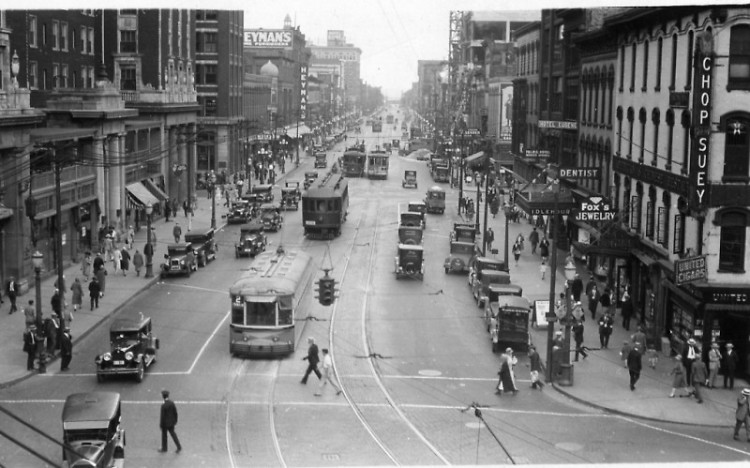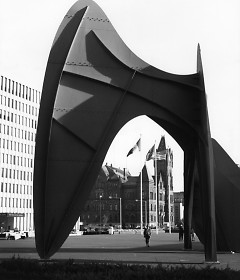Rachel Lee has sound advice for Grand Rapids city residents: “Get involved with your city.” Lee can talk the talk because she has certainly walked the walk. The East Hills resident and now “retired” president of the East Hills Neighborhood Association has quietly been amassing an impressive and unique collection of historic photos of Grand Rapids.
At last month’s SITE:LAB exhibition, Lee projected dozens of the photos as a slide show on the side of the 180 Lake Drive building, similar to her slide show at this past fall’s ArtPeers exhibitions. The images were captivating; ghostly at times, inspiring at others, casting reminders of a not-so-distant past, cataloging the way a street, neighborhood and city can change, decay and be revitalized. The photos of old buildings and long forgotten architecture took on a deeper meaning when displayed on the “screen” of the wall.
“I want to find pictures and artifacts that are not readily available, that are unique, that are not found at the library,” Lee said.
In person, Lee can barely contain her enthusiasm sometimes when speaking about her love of walking through her neighborhood and her impetus to research the origins and development of Grand Rapids.
A self-described “big nerd on GR history” and being “really, really into maps,” Lee began collecting historic photos initially as a hobby that has, like all happy accidents do, sprouted into an endeavor that she finds enriching and rewarding.
Lee’s interest in architecture began when she was an intern in New York City. Describing her life as a pedestrian there, Lee became more and more animated while recounting how she began to “fall in love with the character of NYC architecture.” After moving back to Michigan and settling in East Hills, Lee set out to explore Grand Rapids' city history. Her efforts didn’t go unnoticed, and word soon spread of her project, from an initial phone call from the Grandville Cemetery to leading her eventually to what she describes as “extensive research into private archives.”
Lee began to share her findings via social media. She started posting the photos on her Facebook page and initiated a game where her friends would guess what her posted images depicted. One photo of Michigan Street Hill is completely unrecognizable except for the Immanuel Lutheran Church, the only structure still standing today from the photograph. The response that Lee received from her friends was immensely positive as her friends raced to become the first to identify photos correctly and sharing links to the album on other pages.
“One friend drove around and then walked around three blocks trying to find the exact spot. It gets people talking about history, talking about the city,” Lee said.
A major turning point came when Lee read the book The Geography of Nowhere, by James Kunstler, whom she saw lecture while attending Grand Valley State University. Lee describes the experience as an “eye opener” and inspired her to become more involved with civic activism.
“I began to ask myself ‘how am I contributing?’ Am I making this a better place to live?” she said. Lee feels a connection to Grand Rapids and sees so much potential here. “I feel there is a real opportunity to make a difference in GR.”
When asked why she thought it was important to share this knowledge and educate people on the history of Grand Rapids and to support local businesses and neighborhoods, Lee paused a few beats and gathered her thoughts before responding.
“GR is not anywhere-USA. Supporting local businesses is healthy and good for the environment. You build connections; build relationships; enrich your life with local culture; help create vibrancy," Lee said. "I love being able to walk out my front door and be a half-block away from a variety of restaurants, shops and parks. It’s important to preserve these beautiful buildings because they were built with love and care, and you cannot replace the character you find."
Lee is thorough as well as guarded about her methods. She describes herself as “research oriented” and will “search for the unusual,” recognizing and understanding that each photograph she finds contains many stories within stories. Part of this process is organization and Lee has developed a personal system for logging and tracking her archive.
The future holds quite a lot of promise, and Lee plans to reach a broader base for the photos. In process is a public Facebook fan page called "The Pedestrian" to reach to a larger public than her personal profile page. Lee, who said she has never considered herself an artist, also hopes to on exhibiting her photos in the future, at galleries and continuing her “guerrilla art” by projecting her images on random building facades around Grand Rapids.
A larger and more ambitious project is also underway in the next year for “digitizing each neighborhood” to make historic content more accessible and better connected with specific places.
Lee’s enthusiasm for her research project is clear as evidenced when she speaks of connections she feels to a sense of place, or an "inner geography" seems just as important as the places themselves. In her own words: “It helps us to be creative to see what we can do, and we all have something to do here.”
The Rapidian, a program of the 501(c)3 nonprofit Community Media Center, relies on the community’s support to help cover the cost of training reporters and publishing content.
We need your help.
If each of our readers and content creators who values this community platform help support its creation and maintenance, The Rapidian can continue to educate and facilitate a conversation around issues for years to come.
Please support The Rapidian and make a contribution today.



Comments
Steven,
I enjoy this article, for the citizens of GR to have great pride in there city they must know about how it got the way it did.
Michael Tuffelmire
Thank you Michael. It's good to hear from you.
Correction:
Rachel Lee is the retired president of the East Hills Business Association. She currently still serves on the board of directors for the East Hills Neighborhood Association.
Thanks for this, Steve.